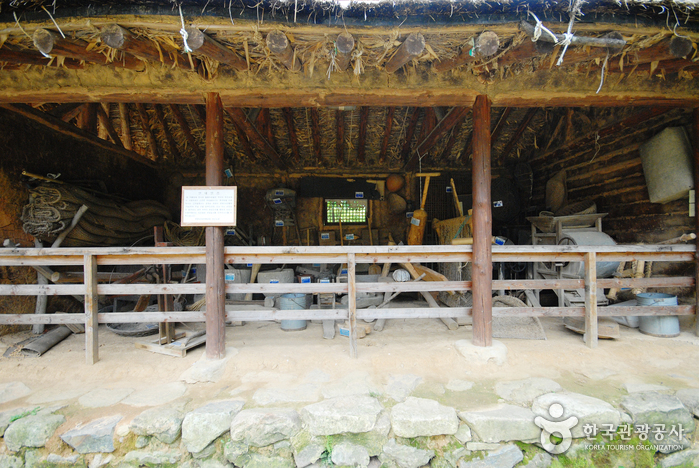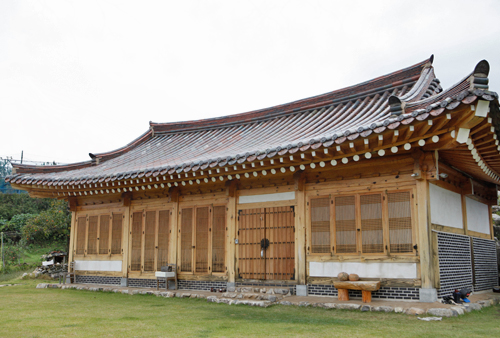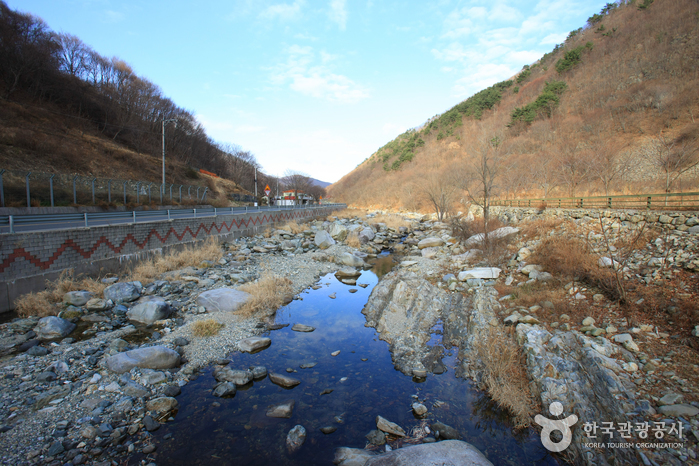Petroglyphs of Bangudae Terrace in Daegok-ri [UNESCO World Heritage] (울주 대곡리 반구대 암각화 [유네스코 세계유산])
10.7Km 2025-07-18
Daegok-ri, Eongyang-eup, Ulju-gun, Ulsan
In Daegok-ri, Eonyang-eup sits Bangudae Terrace, a picturesque spot where a ridge of Yeongosan Mountain extends to and stands tall to form quite a spectacle featuring uniquely shaped rocks and cliffs. The name, Bangudae, comes from how it resembles a turtle lying prone on the ground. Petroglyphs are paintings drawn by people from the prehistoric times carved on rocks and depicting various scenes and events in their daily lives. Petroglyphs were often drawn on enormous rocks and other sacred locations of groups, and it is believed that people gathered around them to hold various rituals.
Petroglyphs of Bangudae Terrace in Daegok-ri, Ulju-gun are estimated to have been drawn over several periods since the New Stone Age, and visitors can observe the differences in styles among various ages. Primary objects that were popularly carved include sea animals, land animals, humans and tools and, as our prehistoric ancestors actively engaged in hunting, the hope of abundance in game is believed to be the reason why these objects were frequently carved on rocks. Vividly expressing animals and hunting scenes and colorfully depicting outstanding traits of objects, these petroglyphs are a form of both hunting art and religious art, and they are considered as the greatest masterpieces that give a peek at the life and customs of the prehistoric ages. The petroglyphs on the Bangudae Terrace and the petroglyphs in Cheonjeon-ri, spanning three kilometers altogether along the Bangucheon Stream, have been inscribed on the UNESCO World Heritage List on July 12, 2025.
Ulsan Daegok Museum (울산대곡박물관)
11.1Km 2021-05-18
257, Seohacheonjeon-ro, Ulju-gun, Ulsan
+82-52-229-4787
Ulsan Daegok Museum displays artifacts that were uncovered from the area of Daegok-ri during the construction of Daegok Dam. Approximately 13,000 relics were excavated during land inspection prior to the dam construction, including Hasamjeong Ancient Tomb. These findings were collected and became available for public display when the museum opened on June 24, 2009.
Unmunsan National Recreational Forest (국립 운문산자연휴양림)
11.3Km 2025-03-28
763 Unmun-ro, Cheongdo-gun, Gyeongsangbuk-do
+82-54--371-1323
* Please be advised that this is located in one of the areas affected by the recent wildfire (as of March 27, 2025).
** For real-time wildfire information and emergency upates, visit the Korea Forestfire Information website and the National Disaster and Safety Portal.
Unmunsan National Recreational Forest in Cheongdo, Gyeongsangbuk-do is located at the foot of Unmunsan Mountain (1,188 meters), which is also called Hogeosan Mountain. It is a great place to spend time in summer for hiking and camping, surrounded by taller mountains (more than 1,000 meters above sea level) such as Munboksan Mountain (1,014 meters) and Gajisan Mountain (1,240 meters).
Yongmipokpo Falls (20 meters) and Byeokgyesu Valley, in which the waters flow across the sandless rock bed, are famous locales in the forest. Located in a thick broadleaf forest, inhabited by many diverse species such as Korean mountain camellia, Unmunsan National Recreational Forest offers lush greenery in summer, beautiful foliage in autumn, and cozy, splendid snowscapes along with the Yongmi Ice Wall in winter. In Unmunryeong, located 2.5 kilometers to the east, visitors can watch the spectacular sunrise above the East Sea.
Petroglyphs of Cheonjeon-ri [UNESCO World Heritage] (울주 천전리 명문과 암각화 [유네스코 세계유산])
11.3Km 2025-07-18
Cheonjeon-ri, Dudong-myeon, Ulju-gun, Ulsan
The petroglyphs (figures, pictures, and letters were made on the rocks along the mid-stream area of Naegokcheon Stream, which is a tributary of Taehwagang River. The upper and lower sides of the rocks contain petroglyphs that differ in the content and techniques used. The upper side contains petroglyphs made by means of chiseling. The inscriptions include geometric patterns, animals, and abstract human figures. There are concentric circles, with a round figure looking like the sun at the center, four running deer next to them, and several semi-human animals. The figures with simplistic expression and symbolism appear to have been made during the Bronze Age.
The lower side contains line-drawn picture mixed with Chinese characters. They include a procession of horse riders, animals including dragons, and boats. In particular, the procession of horse riders appears in three different places. The boats provide researchers with important information on the offshore activities carried out by people of the Silla dynasty. The 800-plus written characters are about the King and Queen’s visit to the place. They were presumed to have been inscribed on two occasions during the reign of King Beopheung (r. 514-540) of the Silla dynasty. The content on the official positions and the government system makes it a precious material for those studying Silla during or around the 6th Century. The petroglyphs were made by many people over an extended period of time, providing vivid information on the life and thoughts of people from prehistoric times to the Silla dynasty.
The petroglyphs in Cheonjeon-ri and petroglyphs on the Bangudae Terrace, spanning three kilometers altogether along the Bangucheon Stream, have been inscribed on the UNESCO World Heritage List on July 12, 2025.
(Source: Korea Heritage Service)
Eoreumgol Hanok Pension (얼음골한옥펜션&캠핑장)
11.6Km 2024-12-13
11-12 , Hayangjian-gil, Miryang-si, Gyeongsangnam-do
+82-10-7100-6203
Eoreumgol Hanok Pension is a hanok pension located between Gajisan Provincial Park and Unmunsan County Park in Gyeongsangnam-do. There are three guest rooms in the pension that have been constructed with red clay, hardwood charcoal powder, and red clay hemp cloth in order to provide health and healing to guests. For convenience, it is equipped with a modern kitchen and bathroom, as well as an outdoor swimming pool, outdoor barbecue facilities, and traditional games like rolling hoops and tuho (arrow-throwing). Each season, the pension operates an outdoor campsite and organizes apple and chestnut picking activities.
Baenaegol Valley (배내골)
14.6Km 2021-04-03
Wondong-myeon, Yangsan-si, Gyeongsangnam-do
+82-55-382-4112
Baenaegol Valley is located at the heart of the mountainous region affectionately known as the Yeongnam Alps. The valley derives its name “Baenaegol,” meaning “the valley of pears,” from the wild pear trees that grow in large numbers along the valley.
The valley covers nearly 8 kilometers of land between the range connecting Sinbulsan Mountain and Yeongchuksan Mountain and the western range connecting Cheonhwangsan Mountain and Jaeyaksan Mountain in Miryang. It is a popular vacation destination in the summer. Also, many tourists come to drink the water containing acer mono sap, which is known to be produced in this region during the springtime.
Baenaegol Valley is just a short distance away from downtown Yangsan. The valley provides an opportunity to enjoy nature away from the hustle and bustle of the city center. The long valley is wedged between highlands, which results in at least two hours less of sunshine than other regions, so it feels cooler in the summer months. Strawberries are also widely grown in the area.
Seokgolsa Temple (석골사)
14.6Km 2024-02-23
167 Wonseo 3-gil, Sannae-myeon, Miryang-si, Gyeongsangnam-do
Seokgolsa Temple, located on Unmunsan Mountain in Miryang, is surrounded by a series of peaks including Unmunsan Mountain to the north, Gajisan Mountain to the east, and Eoksan Mountain to the west. The temple is set in a picturesque landscape, adorned with unique rock cliffs and deep valleys. Below Seokgolsa Temple, the perennial Seokgolsapokpo Falls and valley captivate visitors with their continuous flow of water, attracting a steady stream of tourists and hikers throughout the year.
Naewonsa Temple (Yangsan) (내원사(양산))
14.8Km 2024-02-23
207 Naewon-ro, Habuk-myeon, Yangsan-si, Gyeongsangnam-do
Naewonsa Temple, situated in Cheonseongsan National Park, is home to a monumental Buddha statue standing at 5.5 meters, crafted during the Silla dynasty. The temple complex features various structures, including Bogwangjeon and Geungnakjeon Halls, showcasing its captivating architectural style. Renowned for its picturesque mountain landscapes and as a popular destination for autumn foliage, the temple attracts numerous visitors every year.
Naewonsagyegok Valley (내원사계곡)
14.9Km 2021-02-18
207, Naewon-ro, Yangsan-si, Gyeongsangnam-do
+82-55-380-4826
Naewonsagyegok Valley is located just below Naewonsa Temple at the foot of Cheonseongsan Mountain. The valley is surrounded by Jeongjoksan Mountain to the northeast, Wonjeoksan Mountain to the south, and Cheonseongsan Mountain to the southeast. The water running through the numerous valleys between these mountains has formed streams like Yongyeoncheon and Sangnicheon, which form the Yangsancheon Stream out of Naewonsagyegok Valley.
Naewonsagyegok Valley was formerly called Sogeumgang (little Geumgang), meaning that its beautiful scenery is comparable to that of the breathtaking Geumgangsan Mountain. It is also known as the “mystical valley” as crystal clear water flows all year round. The word “Sogeumgang” is distinctly engraved on one side of the cliff and large rocks stand in layers throughout the valley. Some of the rocks are called Byeongpungbawi Rock, literally meaning folding screen rocks, as they are stretched out much like folding screens.
The valley and the surrounding mountains are a popular summer vacation spot and a well-known hiking destination during the spring, fall, and winter. Muk (acorn jelly) made with acorns gathered from this area not only tastes great, but is also very healthy. Nearby attractions include Tongdosa Temple and Hongnyongpokpo Falls.
* Entrance into the upper region of Naewonsagyegok Valley is restricted.
Olive Young - Ulsan Guyeong Branch [Tax Refund Shop] (올리브영 울산구영점)
15.1Km 2024-06-27
#108~#110, 78, Guyeong-ro, Beomseo-eup, Ulju-gun, Ulsan
-
![Petroglyphs of Bangudae Terrace in Daegok-ri [UNESCO World Heritage] (울주 대곡리 반구대 암각화 [유네스코 세계유산])](http://tong.visitkorea.or.kr/cms/resource/29/2675629_image2_1.jpg)


![Petroglyphs of Cheonjeon-ri [UNESCO World Heritage] (울주 천전리 명문과 암각화 [유네스코 세계유산])](http://tong.visitkorea.or.kr/cms/resource/14/3335114_image2_1.jpg)



 English
English
 한국어
한국어 日本語
日本語 中文(简体)
中文(简体) Deutsch
Deutsch Français
Français Español
Español Русский
Русский